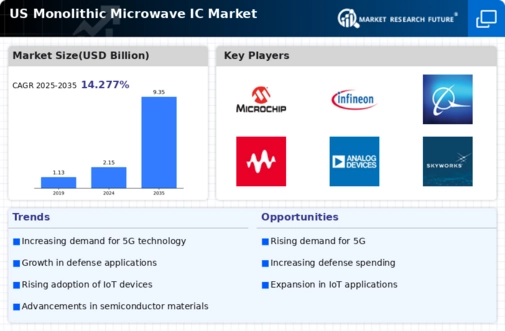Advancements in 5G Technology
The ongoing advancements in 5G technology are driving the monolithic microwave-ic market. As telecommunications companies in the US invest heavily in 5G infrastructure, the demand for high-frequency components is surging. Monolithic microwave-ics are essential for enabling faster data transmission and improved connectivity. The market is projected to grow at a CAGR of approximately 15% over the next five years, reflecting the increasing reliance on these components in 5G applications. This growth is further fueled by the need for enhanced network performance and reduced latency, which are critical for applications such as autonomous vehicles and smart cities. Consequently, the monolithic microwave-ic market is positioned to benefit significantly from the 5G rollout, as manufacturers strive to meet the escalating demand for efficient and reliable microwave components.
Growth in Aerospace and Defense Applications
The aerospace and defense sectors are increasingly adopting monolithic microwave-ics, which is a key driver for the market. These components are crucial for radar systems, satellite communications, and electronic warfare applications. The US government has allocated substantial budgets for defense spending, with an estimated $740 billion for 2025, which is likely to enhance the demand for advanced microwave technologies. Monolithic microwave-ics offer advantages such as miniaturization and improved performance, making them ideal for the stringent requirements of aerospace applications. As the industry continues to innovate, the monolithic microwave-ic market is expected to see a robust growth trajectory, driven by the need for high-performance components in critical defense systems.
Emergence of Internet of Things (IoT) Devices
The proliferation of Internet of Things (IoT) devices is significantly impacting the monolithic microwave-ic market. As more devices become interconnected, the demand for efficient communication technologies is rising. Monolithic microwave-ics play a vital role in enabling wireless communication for IoT applications, which are projected to reach over 75 billion devices by 2025. This surge in IoT adoption necessitates the development of compact and efficient microwave components, thereby driving market growth. The monolithic microwave-ic market is likely to benefit from this trend, as manufacturers focus on creating solutions that cater to the unique requirements of IoT devices, such as low power consumption and high integration levels.
Rising Demand for High-Frequency Applications
The growing demand for high-frequency applications is a crucial driver for the monolithic microwave-ic market. Industries such as telecommunications, automotive, and consumer electronics are increasingly requiring components that can operate at higher frequencies. This trend is particularly evident in the development of advanced communication systems and radar technologies. The market for high-frequency components is projected to grow at a CAGR of around 12% through 2025, indicating a robust demand for monolithic microwave-ics. As manufacturers strive to meet these requirements, the monolithic microwave-ic market is likely to experience significant growth, driven by the need for enhanced performance and reliability in high-frequency applications.
Increased Investment in Research and Development
Investment in research and development (R&D) within the semiconductor industry is a significant driver for the monolithic microwave-ic market. Companies are increasingly allocating resources to innovate and enhance the performance of microwave components. This trend is evident in the US, where R&D spending in the semiconductor sector is expected to exceed $40 billion in 2025. Such investments are likely to lead to breakthroughs in materials and manufacturing processes, resulting in more efficient and cost-effective monolithic microwave-ics. As the industry evolves, the monolithic microwave-ic market is poised to benefit from these advancements, which could lead to improved product offerings and expanded applications across various sectors.






















Leave a Comment